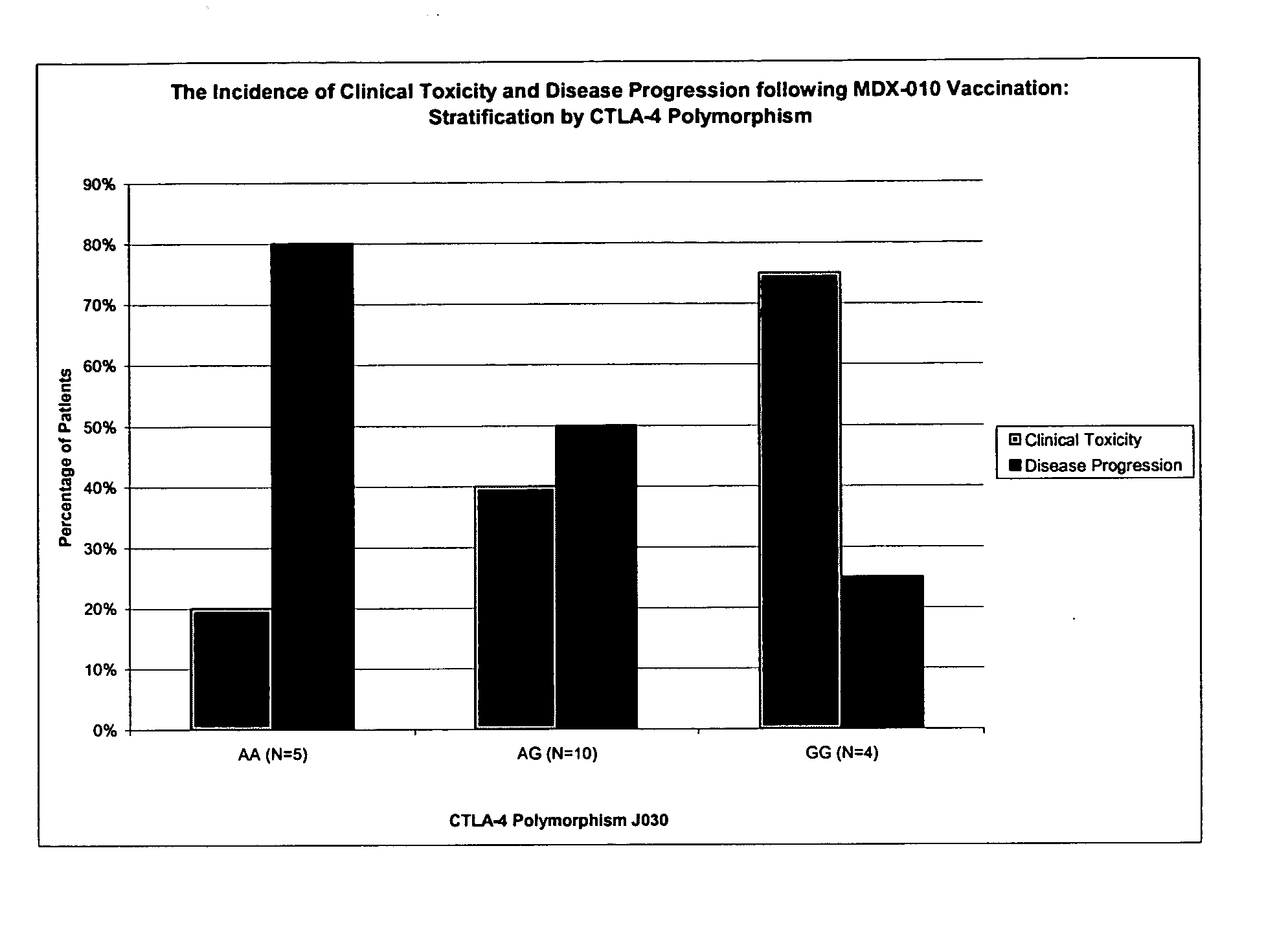Assessment of CTLA-4 polymorphisms in CTLA-4 blockade therapy
- Summary
- Abstract
- Description
- Claims
- Application Information
AI Technical Summary
Benefits of technology
Problems solved by technology
Method used
Image
Examples
example 1
Correlation of Increased Responsiveness to CTLA-4 Blocking Agent Therapy with Presence of Autoimmune Disease-Associated CTLA-4 Polymorphism
[0107] In this example, a clinical study was conducted in which human patients with advanced melanoma were treated with a CTLA-4 blocking agent (the anti-CTLA-4 human monoclonal antibody MDX-010) and a peptide vaccine containing three melanoma antigen peptides (gp100, tyrosinase, MART-1). Each of three cohorts received escalating doses of antibody with vaccine to primarily evaluate the toxicities and maximum tolerated dose (MTD) of antibody with vaccine. MDX-010 pharmacokinetics and immune responses were secondary endpoints.
[0108] Responsiveness to anti-CTLA-4 therapy was assessed and the patients were screened for the CTLA-4 JO30 G / A polymorphism, which is associated with susceptibility to autoimmune disease. The results demonstrate a correlation between the presence of the disease-associated G / G genotype and an increased incidence of clinical...
example 2
Assessment of CTLA-4 Polymorphisms
[0143] Susceptibility to autoimmune disorders such as Graves' disease, autoimmune hypothyroidism (AIH) and type 1 diabetes (T1D) has been mapped to a non-coding 6.1 kb 3′ region of CTLA-4 (Ueda, H. et al. (2003) Nature 423:506-511, the entire contents of which, including Supplementary Information A and B are hereby specifically incorporated by reference). In this study, 108 single nucleotide polymorphisms (SNPs) and the CTLA-4 (AT)n −3′ untranslated region (UTR) marker were genotyped in 384 cases of Graves' disease and 652 controls, in 228 cases of AIH and 844 controls and in 3,671 T1D families. The seven SNPs most closely associated with susceptibility to autoimmune disease were the CT60, JO30, JO31, JO27—1, CTAF343, rs1863800 and MH30 markers. The sequences of these SNPs are as follows, wherein the polymorphic nucleotide position is in brackets, with the first nucleotide representing the disease-associated allele and the second nucleotide represe...
PUM
| Property | Measurement | Unit |
|---|---|---|
| Magnetic field | aaaaa | aaaaa |
| Magnetic field | aaaaa | aaaaa |
| Electric charge | aaaaa | aaaaa |
Abstract
Description
Claims
Application Information
 Login to View More
Login to View More - R&D
- Intellectual Property
- Life Sciences
- Materials
- Tech Scout
- Unparalleled Data Quality
- Higher Quality Content
- 60% Fewer Hallucinations
Browse by: Latest US Patents, China's latest patents, Technical Efficacy Thesaurus, Application Domain, Technology Topic, Popular Technical Reports.
© 2025 PatSnap. All rights reserved.Legal|Privacy policy|Modern Slavery Act Transparency Statement|Sitemap|About US| Contact US: help@patsnap.com


